#casey stoner: pushing the limits
Text
If there was one good thing to come out of that whole season it was that Jorge seemed to realise what he’d been like and the next time I had much to do with him he was completely different. Since then he has become one of the guys that I respect the most out of anybody in the entire paddock. We had similar issues as teenagers, and though we are very different we can relate to each other in lots of ways. I’ve realised we just deal with things differently; for example Jorge’s defence mechanism is to be cocky, whereas I become more introverted and shut down, but we both can be misinterpreted because of how we appear.
The thing I admire most about Jorge is that he admitted his character flaws and made an effort to change, which is impressive for a guy in his position and not something many people are prepared to do. He lives in his own world a lot of the time and he still has that little bit of arrogance about him but he is a massive talent and once you get to know him he’s a very good guy, a great character and nothing but a positive for the sport of motorcycle racing.
- Casey Stoner on Jorge Lorenzo
58 notes
·
View notes
Text

Casey Stoner, Pushing the Limits
GP11:

GP12:
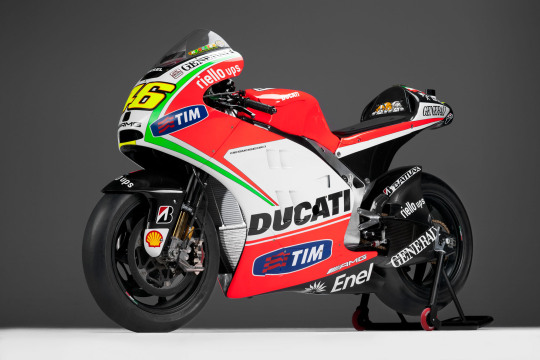

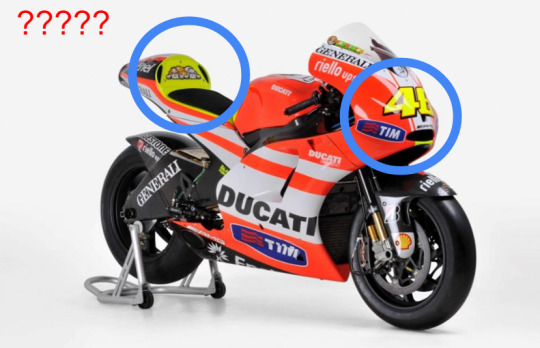


x
#casey stoner#valentino rossi#//#cs27#vr46#i realised i had one important take about the casey/vale rivalry that isn't linked to my actual thesis about them because. listen#i think about this line like. once a week. it haunts me in my sleep. i cannot carry this burden on my own any longer#casey. casey. is it really cOVERED?? with luminous yellow?? COVERED????#i'm not massively fond of the shade of red either but i don't think valentino was involved in making it more orange#my man saw the tiniest hint of yellow and was like 'what the fuck is this'#like valentino's LEATHERS are a wee bit yellow but that's!! not!! the bike!! also casey YOU had the aussie flag on your bloody bike number#the green is also on nicky hayden's gp12 btw like it's LITERALLY JUST THE NUMBER that's yellow#YOU DON'T EVEN SEE THE SEAT WHEN HE'S SITTING ON THE GP11 CASEY IT'S A RED BIKE#i don't have a coherent point about this but it is a LITTLE fascinating! like this made it into his autobiography!!#it's such an interesting thing to even notice no? like you're thinking about their stunning blood red being contaminated?#Does He View Valentino Rossi As An Infection? this is some symbolically potent shit when u think about it#do u think all valentino's victims have like. some kind of deeply ingrained aversion to the colour yellow. pavlovian response and all that#to be clear i find this very funny and i support casey in being a bit demented about valentino. who amongst us
61 notes
·
View notes
Note
we talk a lot about vale making up conspiracy theories in 2015 (he was not delulu idc! but anyways, not the point) but the real conspiracy theory was the one stoner (mainly him) and vale made in 2006 about their tyres being fucked up on purpose. two icons truly.
record scratch freeze frame. vale was ABSOLUTELYYYYYY being delusional in 2015 he was like jorge and marc have unionized against me along with race direction because i am italian. that’s crazy. but! i digress all of these guys especially the aliens are pretty crazy and casey stoner is by no means an exception
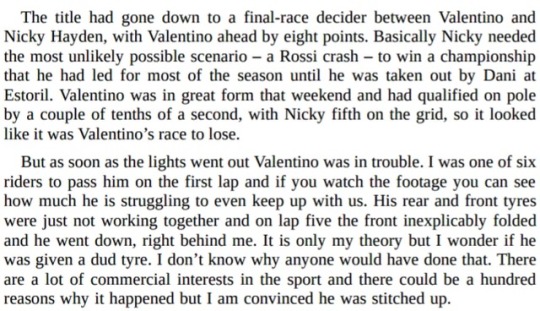
from his autobiography “pushing the limits.” what an odd thing to say.
#you can believe about the kick thing idk about that. but the philip island telemetry incident?? the weird nationalization of it?? cmaaaaan#also him being like marc hated me. valentino girl do you have EYES#motogp#callie speaks#asks#*idc not idk. failure
27 notes
·
View notes
Text
Doomed & Stoned Turns Five!
Coinciding with Doomed & Stoned's fifth anniversary, Todd Severin of The Ripple Effect talks to Editor in Chief Billy Goate about this bitchin' lil blog, from its inauspicious beginning in the summer of 2013 as a simple social media platform to bring together lovers of the doom-stoner sound to dabbling in its own music festival, a massive compilation series, podcasting, and of course album reviews and interviews. Touching on both the joys and challenges of coordinating a multinational team of contributors, Billy discusses battles with burnout, the excitement of new discoveries, and the struggle to stay on top of an exponentially mushrooming music scene.
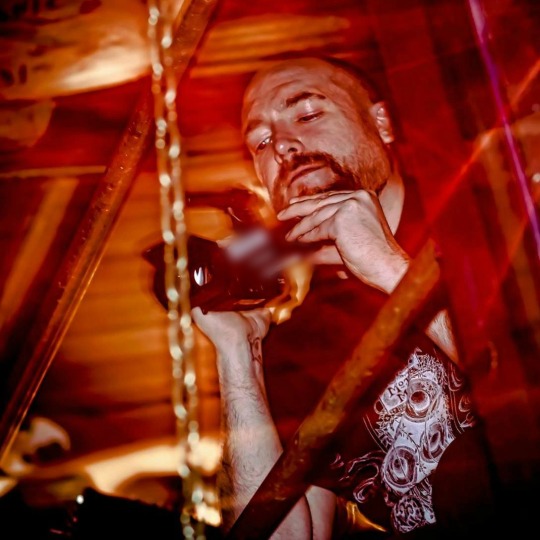
Photo by Chris Schanz
Let's start with the obvious: why Doomed & Stoned?
The name Doomed & Stoned isn't really meant to be edgy, though it does have a nice ring to it. It came to me as a simple way to sum up the heavy vibe that is the heart and soul of our writing: doom metal and stoner rock. I consider those to be the enduring styles of true metal and classic rock 'n' roll, best encapsulated by the music of Black Sabbath. Sabbath played music that was famously downtuned, slow, plodding, and somber, documented so incredibly by those first four albums. Then they had their up-tempo swings that tapped into the feel-good era of the 1970s, "Hole In The Sky" and "The Wizard" comes immediately to mind, as does "Sabbra Cadabra" and a number of songs on Sabbath Bloody Sabbath (1973) -- such a forward-looking album. Black Sabbath is the quintessential doomed and stoned band and it has been, broadly speaking, the stylistic portfolio of music we've decided to hone in on for this venture.


Photos by Alyssa Herrman
As soon as I was turned on to the doom-stoner vibe, I began to notice things happening into my own backyard of Portland, Oregon. At the time, Oregon’s proudest exports were bands like Witch Mountain, Yob, Lord Dying, Danava, and a handful of others that were being signed left and right to labels like Relapse and Profound Lore. Well, I just started documenting everything, because I felt there was something really special happening here, much as there'd been a magical vibe about our sister city Seattle in the '90s when my family had moved up here from East Texas.
It all began with me showing up randomly at shows and shooting live footage, I believe the first was the Portland Metal Winter Olympics in 2014, then Hoverfest. Initially, no one knew who the hell this guy was showing up with his camera, but gradually I became more accepted by the community, which opened up opportunities for doing interviews, album reviews, and a big 75-band compilation of the Portland scene, which kicked off this massive series of scene comps that many know Doomed & Stoned best for.
youtube
Yob at Hoverfest (Film by Billy Goate)
What gave you this crazy idea of promoting the scenes to the rest of the world?
Doomed & Stoned originated out of a frustration I had in sharing discoveries like Windhand, Saint Vitus, Sleep, and Goatsnake with my metal friends. Many wouldn’t give these bands a chance or listened for half-a-minute and gave up. Surely, I thought to myself, there must be others out there who were just as in love with the doom-stoner genre as I am. It wasn’t long until I met Melissa Marie in a metal forum. I told her what I was planning, she was down, and together we burrowed in the heavy underground and discovered a whole community there welcoming us. Melissa was my first contributor and along the way, we made acquaintances with aspiring writers and photographers who really caught the vision and volunteered to document their own scenes. She's since become my executive editor and the organizer of our flagship festival in Indianapolis.

Suzi Uzi and Melissa Marie at Doomed & Stoned Fest
Just like that, the Doomed & Stoned team was born. Roman Tamayo joined the team shortly afterwards, now the Editor of Doomed & Stoned Latinoamérica and I started meeting people from all over who wanted to contribute an album review here, a bit of concert footage there. It all happened very naturally and organically, fueled by simple passion, a mutual love of fuzzy, downtuned riffs, and a desire to document the energy and excitement of what we were all witnessing -- Demon Lung in Las Vegas, Orchid in San Francisco, Pale Divine in Pennsylvania, Pilgrim in Rhode Island. It didn't take us long to discover was going on in the rest of the world and it blew our ever-lovin' minds.
With the explosion in blogging and desktop publishing, we gradually discovered there was a loose network of folks covering the doom-stoner scene all over the world, too. Most of them have been very friendly and we’ve even had the opportunity to collaborate with folks like The Sludgelord, Outlaws of the Sun, The Ripple Effect, Invisible Oranges, Revolver, Blabbermouth, and so many more. There are others that wouldn’t acknowledge our existence -- still won't to this day -- I’m guessing because we were viewed as unwelcome competition in an already small market with a tight circle of friendships. The thing is, we never really wanted to compete with anyone; we just wanted an outlet to share our love of music. It’s hard not to be competitive sometimes, of course. Competition can be positive in that it inspires you to push yourself, try new things, and grow.
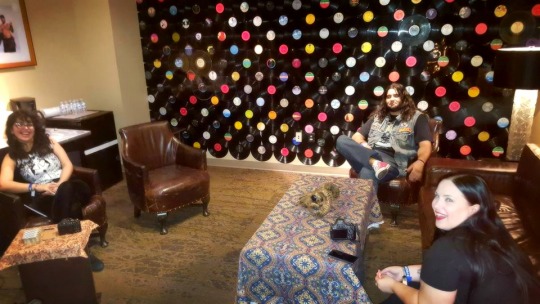
Stephanie Cantu, Frank Heredia, and Elizabeth Gore at Psycho Las Vegas
That said, since none of the 20+ contributors to Doomed & Stoned are doing this full-time, we want ultimately just want to have fun and you can’t enjoy the ride if you’re constantly trying to outdo this site or that. We found our niche in digging into local scenes and telling the stories of the bands who may very well be the next Sleep or Windhand a decade or two into the future.
We're now in the fifth year of our existence and I feel we’re becoming known as people willing to give bands and their local scenes the kind of in-depth coverage they deserve. That speaks to our motto: “Bringing you the music and the stories of the heavy underground, with an emphasis on the Sabbath Sound and local scene coverage -- by the underground, for the underground.”
youtube
Disenchanter at Doomed & Stoned Winter Showcase (Film by Billy Goate)
How has the scene grown and changed in the intervening years?
Well, since those bright-eyed early days, the doom-stoner scene has absolutely exploded. We were lucky enough to time our entry, purely by happenstance, to ride that wave just as it was nearing its crest. Right now, the scene is at least twice as big as it was five years ago and it’s becoming practically impossible to listen to all the new albums coming out, even if we limit the consideration to just doom metal, or even a subgenre of doom like blackened doom or death doom. It becomes a matter of practicality to prioritize those albums that are brought to your attention by PR firms and record labels, but I always remember that some of our greatest discoveries have been unsigned bands.
Over the years, we’ve been lucky enough to discover bands like Disenchanter, Holy Grove, Troll, Year of the Cobra, Toke, and dozens of others that have since risen to international prominence. Just to know you were there the moment their demo showed up on Bandcamp. You were among the first to listen to their self-produced CD on the commute to work. You were there to witness them opening for a touring headliner. You wrote their first review. You made that social media post that sparked a fire of interest. You recommended them to one of your overseas blogger pals. All of that is tremendously gratifying to be a part of.
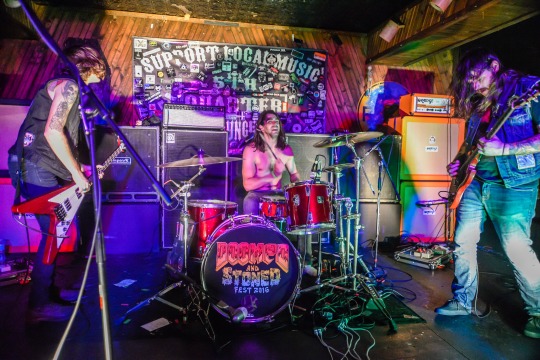
Toke at Doomed & Stoned Festival I (photo by Johnny Hubbard)
We're all the product of our musical past. What's your musical history? First album you ever bought? First musical epiphany moment? First album that terrified the hell out of you?
I was raised by parents who came of age in the ‘50s and ‘60s, so I was exposed initially to a lot of late-‘60s rock, big band jazz, and later the ‘70s radio pop. Mom was fond of playing three classical music albums with a mix of music by Mozart, Beethoven, and Rossini, and that left a very powerful impression on me early on. She also was fond of Olivia Newton John, so I have “Jolene” permanently etched on my psyche and every so often vainly attempt singing it in the shower.
My first vinyl was the Ghostbusters soundtrack, which dad bought for me, and it unleashed a curiosity for the popular music of the ‘80s. Like a lot of my friends at school, I was nuts about Michael Jackson and I remember asking dad if I could have one of those swank red jackets that he wore so famously in “Thriller” (I was denied, though I did get quite good at grade school moonwalking). I distinctly remember the day my family got cable TV for the first time and with it MTV, which brought the music of Metallica, Boy George, Madonna, Aerosmith, and Run-DMC into our conservative Texas household.
It didn’t last long, because somewhere in the mid-‘80s, my family got caught up in the whole “Satanic Panic” movement. They started monitoring my listening habits vigilantly. One day, for instance, my mom was horrified to find her ten-year-old boy singing along to “Nobody’s Fool” by Cinderella during Casey Kasem’s American Top 40 show. From that point on, both rock and metal were banned from the house and my radio was confiscated. It was too late, though, because I was hooked – particularly by metal. Something about it has always moved me in a way that only classical music has matched. My first metal album, which I purchased in secret, was ‘Appetite for Destruction’ by Guns ‘n’ Roses – which at the time represented the pinnacle of late ‘80s heavy metal. People need to understand how revolutionary it was to hear something that “hard” on mainstream radio and MTV. I listened to it and ‘Lies’ incessantly on my Walkman and continued listening clandestinely to FM hard rock and heavy metal.
Since I couldn’t listen to it openly, I started developing an interest in the darker side of classical music, the moodier pieces by Beethoven, Liszt, and Scriabin, and took up playing the piano around 13. My family was supportive of that talent and I would spend hours and hours a day for years playing the piano in solitude. That was my first introduction, in kernel form, to “doom” – especially late Beethoven, when he started growing deaf and began expressing his frustration and despair more poignantly through dark tones. Franz Liszt, later in life, experienced so much tragedy that he begin to write very bleak, obscure music and was one of the first to experiment with atonality.
It wouldn’t be until my college days that I’d come face-to-face with doom at a Saint Vitus show in Portland. From that moment forward, I knew I’d discovered my soul food. Doom metal made an immediate connection, as it addressed the fucked up nature of life and society in a way that felt authentic to me. It wasn’t just anger. It was dark, slow despair and even a blithe kind of acceptance to it all. It was refreshing to have those feelings mapped out in song like that. That triggered a wave of discovery that led to Usnea, Cough, Pilgrim, Demon Lung, Serpentine Path, Undersmile, and others that are now staples of my musical diet.
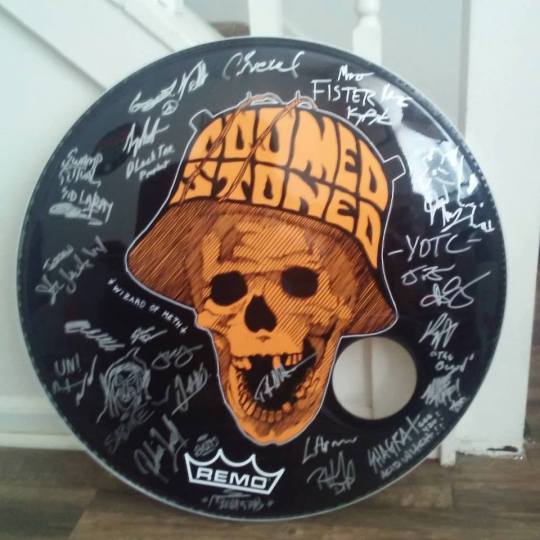
Drumhead from Doomed & Stoned Festival II
What do you see happening in the music scene today, good and bad?
More people are digging to the doom-stoner sound and the scene is growing exponentially. The internet has democratized music in a way that has made it easier than ever for bands to form, record, and share their music. It’s also made it much, much harder for a band to get discovered. We’re simply oversaturated by it all. We’re reaching peak information and many listeners have just stopped exploring altogether. I think there was a study done some years back that said by the late-20’s/early-30’s the average metal listener typically hardens in their musical tastes. I don’t know how true that is still, but I know that I’ve been increasingly suffering from listening fatigue. 2014 was the last year I felt on top of it all. 2015 was explosive and every year since has found me woefully behind in my listening. I’m still digging through the rubble and discovering incredible records that I share now and then in a series of short reviews I call, “Doomed Discoveries.”
Among the trends I’ve seen in our scene in particular is the increase in female-fronted bands (which we tried to document in our compilation, The Enchanter’s Ball) along with more experimentation with genre blending. It’s becoming harder to find bands who traffic in traditional doom, but that’s fine because I think we all needed more diversity in our playlist to keep us from becoming jaded. For a while, it seemed every other band was “witch” this and “black” that. I’m the last person to judge a band by its name, but it was leading to a ton of criticism from fans -- to the point I’d have a hard time getting doom-stoner listeners to take a chance with a newer band that had the word “wizard” in their name. One thing that seems to be a theme of the doom-stoner scene is a continual drive for excellence and evolution. On the negative side, we tend to expect more of our heroes, as a result -- which is why bands like The Sword and Electric Wizard have been criticized for producing music that would have otherwise excited us if they were a brand new band.
youtube
Holy Grove at Hoverfest (Film by Billy Goate)
What's been your all-time greatest "find"? That band you "discovered" before anyone else and started the word spreading?
It’s hard to pinpoint one band, but I’ve been instrumental in boosting the music of Holy Grove, Disenchanter, Troll, and Year of the Cobra -- all bands from out of the Pacific Northwest. Initially they were promoted through Doomed & Stoned and then found their way to small-to-medium sized record labels and festivals. Over half of the bands that played the Vinyl Stage at the Hard Rock Hotel & Casino in the inaugural year of Psycho Las Vegas were my direct recommendations. Though I was less involved in the following year, Psycho Las Vegas booked most of the bands that appeared at Doomed & Stoned Festival, such as Merlin, Toke, and Youngblood Supercult. It was a huge confidence booster in Doomed & Stoned’s ability to be a “taste tester.” This is not to say our taste in bands has always been picked up by festivals or record labels. The scene is getting bigger and out of necessity bands have to diversify their reach through a multiplicity of media outlets, because you never know who will read that one feature at the right time and dig your sound. Besides, there’s too much music in the doom-stoner subgenre for any one site to cover right now, so there are plenty of great recommendations coming from a number of amazing blogs and webzines.
What's the last album to grab you by the throat and insist you listen?
Definitely ‘Celestial Cemetery’ (2017) by Purple Hill Witch. I was only a nominal fan of their first album, but their second one was quite convincing, emotionally. There’s an underlying sadness to the record that appeals to me as a person who has long battled depression.
Celestial Cemetery by Purple Hill Witch
What's the hardest thing you encounter in promoting shows?
Convincing people that live music is worth leaving the comfort of our homes to experience, to say nothing of many benefits that come from connecting others in the underground music community. These days, we tend to value how conveniently something can be delivered to us. Audio books have replaced the need to sit and read (and collect printed media), our homes have become veritable theaters so no need to go out for movies anymore, and streaming high-definition music makes us feel like we’re in some sense getting the real deal.
Of course, those of us who go out to shows know there’s just no substitute for the excitement, energy, and sound of a well-produced live show, especially in a small venue. This is to say nothing of the community that comes with it. My best friendships in the scene have come about because I chose to breach my comfort zone and venture out to a show, sometimes merely on a whim. With that said, I admit I struggle with convincing myself to go out. It’s the introvert in me, I suppose. However, I have a saying that I try to live by: “Feel the fear and do it anyway.”
youtube
Witch Mountain -- first tour with Kayla Dixon (Film by Billy Goate)
If you could write a 1,000 word essay on one song, which one would it be, and why? What makes that song so important?
Funny, I actually did write a 1,000+ word essay on Cough’s “Possession” -- the only song I’ve been moved to write an entire piece about so far. I think it’s because it spoke to me during a time in my life where I was feeling such raw, charged emotion and witnessing a personal transformation from being a happy-go-lucky, easy-going dude, to someone emptied of hope and weighted down by a very nihilistic outlook and pessimistic thinking. This was, in turn, keeping me more closed off from other people, because my trust level was at an all-time low.
I’ve always valued music for its ability to commiserate with me in my circumstances. During Basic Training it was Superunknown and Down on the Upside by Soundgarden. In my college days, it was Alice in Chain’s last album just prior to the death of Layne Staley, which fans nicknamed Tripod. In 2016, Cough returned after a long absence, released Still They Pray, and headlined the first ever Doomed & Stoned Festival in Indianapolis. It was a year of transition for me with a lot of upheaval in my personal life and “Possession” seemed to capture my inner storm perfectly, which inspired me to write a few words about it.
Give us three bands that we need to keep our eyes out for.
White Wail: The grooviest psychedelics this side of Berlin are nested right here in Yob country, my hometown of Eugene, Oregon. White Wail is best described as part-Graveyard, part-Radio Moscow, with a special kind of DIY electricity that has made them hands down one of the most entertaining live acts in the region. Their upcoming second album is going to put them on the map for many people, I predict.
I by White Wail
Reptile Master: Norwegian doom-sludge clan with two guitars, two basses, a drum, and one unhinged vocalist. You’ll find none fiercer. “The Sorcerer’s Weed” (opening number off their first LP, In The Light of a Sinking Sun) is positively frightening. I can feel its seething rage filling up my chest cavity like pneumonia every time I listen to it. I believe they’re expecting a new album out in the first quarter of 2019, if not sooner, and I can't wait!
Chrome Ghost: The ultimate contrast of light and dark come to us from a relatively unknown band in Roseville, California. The secret sauce here involves incredible vocal harmonies pitted against massive, crunchy riffs, something that’s done very effectively in their recent EPs, ‘The Mirror’ (2018) and ‘Reflection Pool’ (2017). Now, they just need to take this show on the road so the world can get better acquainted with them.
Shallows by chrome ghost
Tell us about your personal music collection. Vinyl? CD? What's your prized possession?
People think I have a huge vinyl collection, but mine is quite modest, really. Don’t get me wrong, I’d love to have a bigger collection and show it off, but unfortunately, I haven’t a lot of money to put into it, really. My most prized records come from bands I’ve supported from their earliest stages, like Holy Grove, Menin, Soom, or Vokonis. CDs have come to dominate my collection, not so much by choice, but quite a few promos are sent to me that way. Mostly, I have a vast digital collection that takes up almost six terabytes of data. Since I’m doing a lot of podcasting, this allows me the easiest point of access to put together my mixes for The Doomed & Stoned Show.
youtube
BelzebonG at Psycho Las Vegas (Film by Billy Goate)
What is it about this particular type of heavy music that makes it mean so much to you?
To me, doom metal and stoner rock has incredible staying power. It’s something I can listen to over and over again without growing weary of it. Add to that the fact bands in this genre take so much care in crafting their live sound and you can go to any doom-stoner show knowing you’re going to have an incredible time, perhaps even walk away with a better experience than the record gave you. I was constantly disappointed by the concert experiences I had while immersed in mainstream metal. It just never sounded as good as the records did. With doom-stoner music, my experience has largely been that a band's show can, and often does, transcend their studio recordings. It’s just the ethic of our scene; we're fanatical about sound.
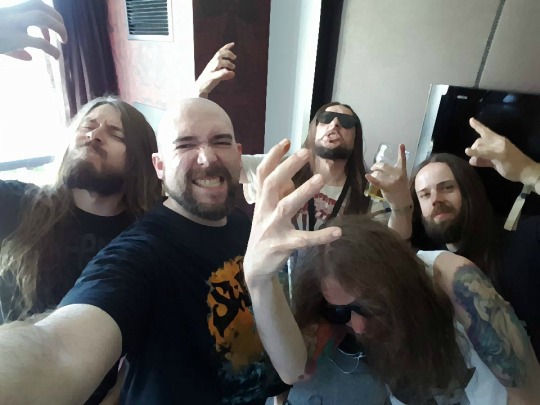
With BelzebonG
What makes it all worthwhile for you?
That's a really good question. My philosophy is that as long as we’re all still having fun, it’s worth it to keep doing Doomed & Stoned. With that said, it can be very demanding and stressful, especially as we’re increasingly turned to by bands, labels, and PR firms to host track and album premieres. The gratification of a piece well done -- whether by me or by one of my team members -- is ultimately what keeps me going day-to-day. I find a lot of joy in developing talent and even helping writers and photographers hone their craft, gain greater name recognition, and develop the confidence to even branch out on their own as freelancers. Several have gotten gigs with larger outlets like Noisey due to their work here and that just blows my mind.
When Melissa first started, she wasn’t confident at all that she could do an interview. Next thing you know, she’s interviewing Wino, negotiating contracts with promoters, booking venues, and organizing a music festival with international acts. I’ve very proud of the team and everyone who has been a part of it, if only for a season. I'd add to that my relationships with growing record labels and ambitious promoters, who I've been able work with to get bands like Tombstones, BelzebonG, Spelljammer, Vokonis, Cardinals Folly over here to play for the first time in the United States.
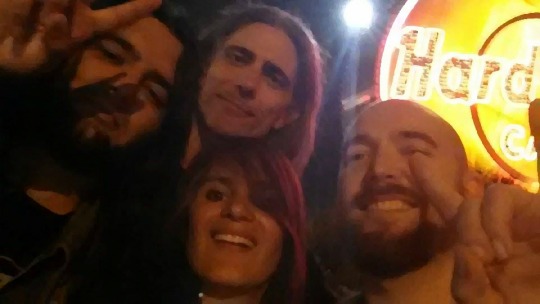
With Disenchanter
How would your life be different if you weren't spreading the word about music?
I suppose I’d be spending more time playing the piano, something I’ve neglected more than I’d like to admit since starting Doomed & Stoned. There are some gnarly pieces by Beethoven, Liszt, Scriabin, Godowsky, and Prokofiev that I've half-chewed, just waiting for me pick them back up again. Either way, I don’t think I can stay passively involved in music. I have to be playing it or writing about it, preferably both.
youtube
Usnea play 'Random Cosmic Violence' (Film by Billy Goate)
Ever been threatened by a band or a ravenous fan?
No, but I’ve been doggedly pursued on Facebook by overly enthusiastic bands trying to get me to review their albums. What they don’t realize is that I’ve got a very heavy editing backlog -- it takes at least 2 hours and more commonly 4, 6 or even 8 hours –- to prep a feature length piece for publication. To review a record, I need even more time to let it soak in. I have to find something in it that connects with me on an emotional or at least an intellectual level or I can’t write about it. Because of that, I don’t write very many reviews a years. Maybe a half-dozen traditional, track-by-track reviews, though I do try to write at least one short review a week on our Facebook page.
Part of the blessing and the curse of doing this as a hobby, as opposed to full-time, is I don’t have a lot of opportunity to hear gossip, get into interpersonal dramas, know who's not speaking to whom -- that kind of thing. With that said, I really wish I could spend more time responding to every message I receive and developing deeper level friendships. Perhaps in time I will. My work schedule is so packed right now that it’s very hard for me to tear away and just relax and get to know people. On the positive side, it does save me from a lot of inter-scene conflict and allows me to be more of a neutral party when issues arise between bands, venues, promoters, forums, or fans.
youtube
Saint Vitus Live in Portland (Film by Billy Goate)
In the end, what would you like to have accomplished, or be remembered for?
I’m hoping we can be remembers for documenting this special era in heavy music history. I want to get better at showcasing the bands in their scenes and telling their stories, just like the writers and photographers of the Seattle grunge era were able to capture the imagination of the world with the Nirvana-Soundgarden-AIC-Pearl Jam vibe of that scene in the early-to-mid ‘90s -- what the 1996 documentary Hype! captured so well. I also hope I’ll be remembered for writing interesting, engaging, and relatable music reviews that aren’t pretentious crap. That’s still a work in progress!
youtube
Bell Witch at Doomed & Stoned Fest (Film by Billy Goate)
Many people may not realize the hours you devote to what you do for little or no pay. Is there a day job? If so, how do you find the balance?
This is most certainly not a day job. I have a full time job that I work 40-50 hours a week and I do Doomed & Stoned in the evenings and weekends. Right now, I’m not doing very good with the balance, to be honest. I’m an unrepentant workaholic, if I’m being honest with myself. That said, every other weekend, my mind and body revolt and refuse to allow me to do anything except sleep or just lay around watching movies or doing normal things like, you know, mowing the lawn. If I could will it, I wouldn't sleep more than four hours a night, hit every show that comes to town, review every new release, put out a podcast every week, edit every article within a few days of it being submitted to me. In other words, I'd manage Doomed & Stoned as if it were a full-scale entertainment website. However, I have to remind myself that I started this to build community and to have fun, so it’s okay to operate on a different model.
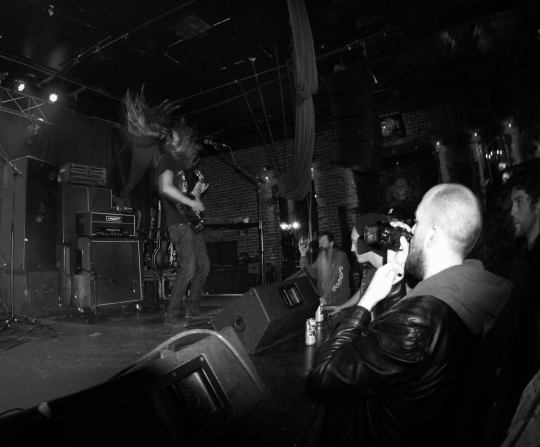
Filming Elder at Dante's in Portland (Photo by Matt Amott)
What's next? Any new projects?
This year, we’re on a roll with our compilations, thanks to some wonderful organizers who are embedded in their local scenes and are good at rounding up tracks from all the participating bands. We’ve released Doomed & Stoned in Ireland, Doomed & Stoned in Philadelphia, and Doomed & Stoned in New Zealand, Doomed & Stoned in South Africa, Doomed & Stoned in Sweden, and we're coming up on Doomed & Stoned in Deutschland, and our fifth anniversary compilation, Doomed & Stoned in Portland III.
Other than that, we’re in the third year of our flagship festival, Doomed & Stoned Festival, which takes place on October 6th & 7th in Indianapolis. Over the summer, we’ve had two new festivals: Chicago Doomed & Stoned Festival and Ohio Doomed & Stoned Fest. We’ll likely be doing a festival in Portland later in the summer, too, perhaps doing an all-dayer in Eugene, too. These are very much passion projects and we're lucky to break even on them, but the joy of putting on a successful fest that brings together members of the community, that brings bands like Vokonis and Cardinals Folly to the United States for the first time, is totally worth it. This is history in the making. More than that, it's vital therapy for our people -- refueling our storehouses with the power of the Riff!
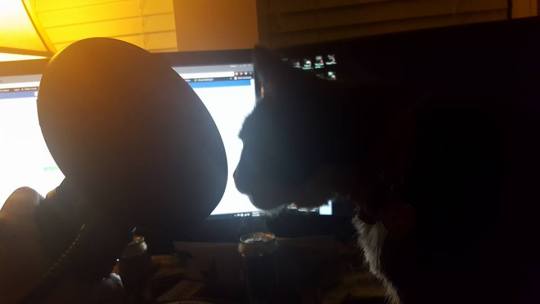
Finally, other than the music, what's your other burning passion?
I have cats that I love to death. I’m a fanatical collector of B-movies, from the ‘60s and ‘70s especially –- the more awful the movie is, production wise, the more I delight in it. Probably that has a lot to do with growing up on Mystery Science Theater 3000. When B-movies and cats collide with music, I’m in a very happy place (see the band Gurt!). Also an avid fan of vintage comic books -- many of the narratives of the pre-code 1950s comic books were taking chances that rival many of the shocking storylines of Marvel and DC today. Surprisingly, one of the themes that I see recurring between titles is DOOM! It's a delight every time I discover one of these stories. Art, film, and music have a very important, symbiotic relationship and I find it tremendously gratifying to play historian and trace the threads of the past into the present and watch how they continue to evolve into the future.
I've also got a gang of cats that keep me in line and like to be very involved with the production of Doomed & Stoned, so much so that I've had to make cat beds in front of my monitor and in the drawer of one of my desks for a pair of twins I adopted from the pound some years back. They absolutely are enthralled with that desk of mind, whether I'm editing an article or interviewing someone for a show! Best of all, they love them some doom. They sleep soundly every time I've got the likes of Sea Bastard or Serpentine Path rumbling my speakers. Wouldn't trade 'em for all the vinyl in the world.

Meet The Team
North America
Billy Goate (Editor in Chief -- Oregon), Melissa Marie (Executive Editor -- Indiana), Frank Heredia (California), Elizabeth Gore (California), Stephanie V. Cantu (Texas), Chris Schanz (Washington), Papa Paul (Pennsylvania), Zachary Painter (Texas), Alex Watt (Oregon), Alyssa Herrman (Oregon), Hugo Guzman (California), Lara Noel (Chicago), Suzi Uzi (Chicago), Jamie Yeats (Montana), Stephanie Savenkoff (Oregon), Corey Lewis (Oregon), Colton Dollar (California), Adam Mundwarf (Oregon), Dan Simone (Ohio), Shawn Gibson (North Carolina), Tom Hanno (New York), Eric The Red (Oregon), Justin Cory (Oregon), Jamie LaRose (Florida).
International
Roman Tamayo (Mexico), Sally Townsend (Australia), Calvin Lampert (Switzerland), Mari Knox (Italy), Svempa Alveving (Sweden), Juan Antonio (Spain), Angelique Le Marchand (UK), Jacob Mazlum (UK), Mel Lie (Germany), Silvi Pearl (Austria), Simon Howard (Australia), Matthew Donk (UK), Willem Verhappen (Netherlands).
Doomed & Stoned would also like to thank contributions from Ben Edwards, Brian Schmidt, Bucky Brown, Cherry Darling, Chris Latta, Curtis Parker, David Glass, David Knottnerus, Doomstress Alexis, Doug McHardlane, Drew Smith, Eleanna Safarika, Gonzalo Brunelli, Gustav Zombetero, Hannah Rachel Lowe, Jake Wallace, Joey Demartini, Johnny Hubbard, Jules Maher, Leanne Ridgeway, Marcel van der Haar, Mathew Jacques, Mona Miluski, Patrick Alex Thorfinn, Paul Bracamonte, Randy Beach, Sabine Stangenberg, Sandra Mez Russotto, Sandy Wright, Sarah Eriksson, Sean Schock, Stef Dimou, Steph LeSaux, Steve Howe, Thäedra Clare, Wendy Yashira, Ygor Silva, and so many others who have supported us directly or indirectly.
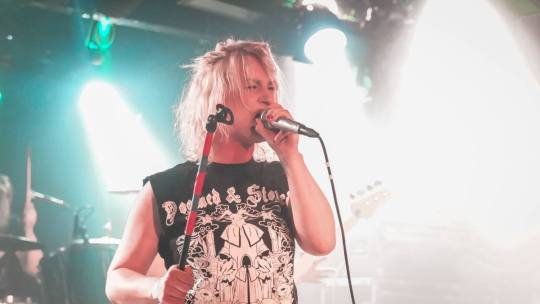
Mona Miluski from High Fighter sporting our basic black
Show your Doomed & Stoned pride! Get a t-shirt or sticker and become a patron of The Doomed & Stoned Show. You can also check out and share our free scene-by-scene compilation series. Donations help us to fund cool projects, such as new t-shirt designs, patches, etc. and helps with the much needed funds for web-hosting, data storage, and lots more besides. Most of all, we value your regular readership. Thanks so much for being a member of the Doomed & Stoned family!
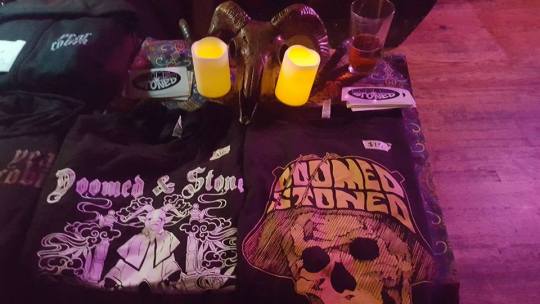
#Doomed & Stoned#Doomed & Stoned Festival#Purple Hill Witch#Chrome Ghost#White Wail#Reptile Master#Yob#Disenchanter#Holy Grove#Witch Mountain#Saint Vitus#Bell Witch#BelzebonG#Doom#Metal#Doom Metal#Stoner Rock
3 notes
·
View notes
Text
The limits of coworking
It feels like there’s a WeWork on every street nowadays. Take a walk through midtown Manhattan (please don’t actually) and it might even seem like there are more WeWorks than office buildings.
Consider this an ongoing discussion about Urban Tech, its intersection with regulation, issues of public service, and other complexities that people have full PHDs on. I’m just a bitter, born-and-bred New Yorker trying to figure out why I’ve been stuck in between subway stops for the last 15 minutes, so please reach out with your take on any of these thoughts: @[email protected].
Co-working has permeated cities around the world at an astronomical rate. The rise has been so remarkable that even the headline-dominating SoftBank seems willing to bet the success of its colossal Vision Fund on the shift continuing, having poured billions into WeWork – including a recent $4.4 billion top-up that saw the co-working king’s valuation spike to $45 billion.
And there are no signs of the trend slowing down. With growing frequency, new startups are popping up across cities looking to turn under-utilized brick-and-mortar or commercial space into low-cost co-working options.
It’s a strategy spreading through every type of business from retail – where companies like Workbar have helped retailers offer up portions of their stores – to more niche verticals like parking lots – where companies like Campsyte are transforming empty lots into spaces for outdoor co-working and corporate off-sites. Restaurants and bars might even prove most popular for co-working, with startups like Spacious and KettleSpace turning restaurants that are closed during the day into private co-working space during their off-hours.
Before you know it, a startup will be strapping an Aeron chair to the top of a telephone pole and calling it “WirelessWorking”.
But is there a limit to how far co-working can go? Are all of the storefronts, restaurants and open spaces that line city streets going to be filled with MacBooks, cappuccinos and Moleskine notebooks? That might be too tall a task, even for the movement taking over skyscrapers.
The co-working of everything…
Photo: Vasyl Dolmatov / iStock via Getty Images
So why is everyone trying to turn your favorite neighborhood dinner spot into a part-time WeWork in the first place? Co-working offers a particularly compelling use case for under-utilized space.
First, co-working falls under the same general commercial zoning categories as most independent businesses and very little additional infrastructure – outside of a few extra power outlets and some decent WiFi – is required to turn a space into an effective replacement for the often crowded and distracting coffee shops used by price-sensitive, lean, remote, or nomadic workers that make up a growing portion of the workforce.
Thus, businesses can list their space at little-to-no cost, without having to deal with structural layout changes that are more likely to arise when dealing with pop-up solutions or event rentals.
On the supply side, these co-working networks don’t have to purchase leases or make capital improvements to convert each space, and so they’re able to offer more square footage per member at a much lower rate than traditional co-working spaces. Spacious, for example, charges a monthly membership fee of $99-$129 dollars for access to its network of vetted restaurants, which is cheap compared to a WeWork desk, which can cost anywhere from $300-$800 per month in New York City.
Customers realize more affordable co-working alternatives, while tight-margin businesses facing increasing rents for under-utilized property are able to pool resources into a network and access a completely new revenue stream at very little cost. The value proposition is proving to be seriously convincing in initial cities – Spacious told the New York Times, that so many restaurants were applying to join the network on their own volition that only five percent of total applicants were ultimately getting accepted.
Basically, the business model here checks a lot of the boxes for successful marketplaces: Acquisition and transaction friction is low for both customers and suppliers, with both seeing real value that didn’t exist previously. Unit economics seem strong, and vetting on both sides of the market creates trust and community. Finally, there’s an observable network effect whereby suppliers benefit from higher occupancy as more customers join the network, while customers benefit from added flexibility as more locations join the network.
… Or just the co-working of some things…
Photo: Caiaimage / Robert Daly via Getty Images
So is this the way of the future? The strategy is really compelling, with a creative solution that offers tremendous value to businesses and workers in major cities. But concerns around the scalability of demand make it difficult to picture this phenomenon becoming ubiquitous across cities or something that reaches the scale of a WeWork or large conventional co-working player.
All these companies seem to be competing for a similar demographic, not only with one another, but also with coffee shops, free workspaces, and other flexible co-working options like Croissant, which provides members with access to unused desks and offices in traditional co-working spaces. Like Spacious and KettleSpace, the spaces on Croissant own the property leases and are already built for co-working, so Croissant can still offer comparatively attractive rates.
The offer seems most compelling for someone that is able to work without a stable location and without the amenities offered in traditional co-working or office spaces, and is also price sensitive enough where they would trade those benefits for a lower price. Yet at the same time, they can’t be too price sensitive, where they would prefer working out of free – or close to free – coffee shops instead of paying a monthly membership fee to avoid the frictions that can come with them.
And it seems unclear whether the problem or solution is as poignant outside of high-density cities – let alone outside of high-density areas of high-density cities.
Without density, is the competition for space or traffic in coffee shops and free workspaces still high enough where it’s worth paying a membership fee for? Would the desire for a private working environment, or for a working community, be enough to incentivize membership alone? And in less-dense and more-sprawl oriented cities, members could also face the risk of having to travel significant distances if space isn’t available in nearby locations.
While the emerging workforce is trending towards more remote, agile and nomadic workers that can do more with less, it’s less certain how many will actually fit the profile that opts out of both more costly but stable traditional workspaces, as well as potentially frustrating but free alternatives. And if the lack of density does prove to be an issue, how many of those workers will live in hyper-dense areas, especially if they are price-sensitive and can work and live anywhere?
To be clear, I’m not saying the companies won’t see significant growth – in fact, I think they will. But will the trend of monetizing unused space through co-working come to permeate cities everywhere and do so with meaningful occupancy? Maybe not. That said, there is still a sizable and growing demographic that need these solutions and the value proposition is significant in many major urban areas.
The companies are creating real value, creating more efficient use of wasted space, and fixing a supply-demand issue. And the cultural value of even modestly helping independent businesses keep the lights on seems to outweigh the cultural “damage” some may fear in turning them into part-time co-working spaces.
And lastly, some reading while in transit:
The Grim Future of Urban Warfare – The Atlantic, Darran Anderson
New York’s New Wage Law for Uber Drivers is a Lesson for Cities Around the World – MIT Technology Review, Erin Winick
Can New Home Building Tech Help Solve the Affordability Crisis? – FastCompany, Adele Peters
Homelessness Rises More Quickly Where Rent Exceeds a Third of Income – Zillow Research, Chris Glynn & Alexander Casey
Vote on Temescal to Test Core Values – StreetsblogSF, Roger Rudick
L.A. Approves New Rules for Airbnb-Type Rentals After Years of Debate – Los Angeles Times, Emily Alpert Reyes
Can France Revive its Industrial Heartland? – FT, Harriet Agnew
Why Communities Across America Are Pushing to Close Waste Incinerators – CityLab, Rebecca Stoner
from iraidajzsmmwtv https://ift.tt/2PFeXFz
via IFTTT
0 notes
Text
New Post has been published on Superbike News
New Post has been published on http://superbike-news.co.uk/wordpress/all-or-nothing-who-can-beat-the-king-of-the-sachsenring/
All or nothing: who can beat the King of the Sachsenring
Since his MotoGP™ debut in 2013, no one has beaten reigning Champion Marc Marquez (Repsol Honda Team) to the top step at the Sachsenring – or even before. The number 93 has eight straight wins at the track: one in the 125 World Championship in 2010, two in Moto2™ in 2011 and 2012, and every year since in the premier class. That’s makes the goal for the rest of the grid a simple one as we barrel towards the summer break: beat the King of the Sachsenring.
It won’t be easy. The final battle of the first half of the season will take place at another venue steeped in history and although the track itself is newer, the anti-clockwise venue is a unique one. The weather could also play a role, with the German GP always more of a question mark than many other tracks on the grid. But the field won’t leave it to chance – with the points gap behind Marquez only continuing to grow, they can’t afford to.
So who will be taking on the king of the 3,5km Sachsenring? His biggest competition may well come from teammate Dani Pedrosa, whose MotoGP™ record at the German track is equaled only by his record at Valencia. The number 26 has won four times at the venue, and with a Press Conference on Thursday at which he’ll be announcing details of his future, it will be a big weekend for the three-time World Champion.
Valentino Rossi (Movistar Yamaha MotoGP) is another name with a great CV at the track, including four premier class wins. He’s also the closest challenger to Marquez in the title fight as it stands, making it everything to play for for the nine-time World Champion. A winner at the venue for two manufacturers, too, Rossi will surely be a threat – as will teammate Maverick Viñales. Viñales’ record isn’t as shimmering, with two podiums in the lightweight class, but the Spaniard beat the ‘Doctor’ over the line last season and has his own aspirations to the crown, sitting third overall…
Last season, however, Andrea Dovizioso (Ducati Team) beat both the Movistar Yamahas to complete the podium. The Italian has a solid record at the track added to by the rostrum finish, and the Borgo Panigale factory have won there before, back in 2008 with Casey Stoner. ‘DesmoDovi’ needs some form and began to recover that in Assen, taking fourth to move up to fifth in the standings – can he keep the tide turning a little on teammate Jorge Lorenzo in Germany? The Sachsenring is one of very few venues where the number 99 has never won, but two out of the last three wins for Lorenzo makes it a big statement for Dovizioso if he can turn the odds against the Spaniard.
Alex Rins (Team Suzuki Ecstar) is on song and took his best ever finish last time out, teammate Andrea Iannone will want to fight back and Cal Crutchlow (LCR Honda Castrol) has a solid record at the track – as do Honda as a manufacturer. Johann Zarco (Monster Yamaha Tech 3), meanwhile, has a tough act to follow after then-teammate Jonas Folger pushed Marquez to the limit last season – but the Frenchman says he has the data. Will that help him turnaround what was one of his toughest weekends as a rookie and make it second time lucky?
It’s the final race before the summer break and the last chance for many to regain some momentum before we take some time off. With Marquez so far ahead the reigning Champion can afford to take a few risks in Germany – but his competitors can’t afford to let him. Tune in for the German GP from Friday 13th of July, before the race puts another 25 points on the table on Sunday 15th.
Championship Standings
1 – Marc Marquez (SPA) HONDA 140 points
2 – Valentino Rossi (ITA) YAMAHA 99
3 – Maverick Viñales (SPA) YAMAHA 93
4 – Johann Zarco (FRA) YAMAHA 81
5 – Andrea Dovizioso (ITA) DUCATI 79
0 notes
Text
How College “Psychedelic Clubs” are Changing the Conversation on Drugs
“The first meeting we had, we were just nine people sitting in a circle under a tree,” James Casey told me. Casey, the current director of the Psychedelic Club at the University of Colorado, was sitting in a noisy Boulder coffeehouse recalling the club’s origins. Next to him sat Nick Morris, the club’s founder. “Nick suggested we go around and everyone say their name, and this other person says, ‘���and your spirit animal!’”
Morris and Casey traded glances and laughed. “I just cringed,” Casey recalled.
After the first meeting, Casey approached Nick. “This thing has a lot of potential,” Casey told the club’s founder. “We can really make something beautiful.”
That was two years ago, and the tone has changed quite a bit since. Today, they see about 40 heads per meeting.
“We have a wide range of people,” said Morris. “We have people who know psychedelics down to their chemical structure. And we have some who only know what a psychedelic is—and that’s all they know. We get people who are really deep into psychedelic culture, and we get people who are 4.0 neuroscience majors.”
A few months ago I read about CU’s Psychedelic Club in a local student newspaper. The club’s name, a kind of throwback to the Timothy Leary era, intrigued me. I couldn’t shake the question: What would a Psychedelic Club meeting look like?
Morris invited me to come out and see for myself. I half expected to meet two guys with enough edge that said, “Hello, we made a drug club.” Instead, Morris and Casey perfectly blended into Boulder’s casual college scene. Both wore flannel shirts. The only concession to psychedelia was Casey’s Pink Panther baseball cap.
Once we found the bottom of our teas, Morris, Casey and I stepped outside into the watery slush left by the recent storm and made our way to the Environmental Design building where the club meets.
University of Colorado, Boulder campus. (Ryan Dearth for Leafly)
• • •
The spirit of the room was relaxed and light. Students twisted in their seats, ate pizza, and chatted with their friends. Casey announced that they’d be having a low-key meeting today: writing or sharing poems, then electing a new slate of club leaders.
Students excitedly grabbed paper and let poetic meter spill onto it. For fifteen minutes, the only sounds in the room were pen scratching paper and computer keys clicking. One student volunteered to share his work. He stood, wearing a shirt that said “Legalize It.” He read a poem he had saved from a while back, written after a profound psychoactive experience.
His poem captured the anxiety felt as the clock counts down our years of life with a steady tick-tock – a sound that becomes ever more ominous when burned away at a 9-to-5 job.
The end of his poem was met with a single “Oh my god” from one impressed student, and a chorus of applause. Other students shared their work with an unusual openness. No one seemed to be intimidated by the performance that preceded their own. It was simply one person followed by another, each sharing their own perspective.
In the meeting’s waning minutes, three students shared their visions for the club’s coming year. The student who’d read the first poem unveiled plans to meet with faculty and legislators to design safer approaches and drug education for students who are curious, uninformed, or struggling.
And that’s where the Psychedelic Club’s real work begins.
CU Psychedelic Club founders James Casey and Nick Morris standing at a campus balcony before a club meeting. (Ryan Dearth for Leafly)
• • •
College cannabis clubs are nothing new; many have been around since the 70s. NORML counts at least 20 student chapters on college campuses around the country. Students for Sensible Drug Policy have over 4,000 cannabis activists at work today.
But psychedelic clubs are a little different. Though all support legal reform, these groups mainly focus on education, peer-to-peer information exchange, and harm reduction. Since the founding of CU’s club two years ago, fifteen clubs have sprouted across the country, from California to North Dakota to North Carolina. Each club grows organically, according to the desires of the members and the environment on campus.
Psychedelic Club is spreading across the US, with 15 chapters coast-to-coast. That number is constantly growing.
“At first we wanted it to be mainly awareness-based, just educating the public,” said Morris, the CU club founder.
That quickly changed. Club members identified a need for harm reduction programs and evidence-based information about the psychedelics circulating around Boulder. “We eventually started doing substance testing for students as well as trip sitting,” Casey added.
The club’s testing work revealed some shocking results. Over 80 percent of the MDMA that club members analyzed turned out to be cut with methamphetamine.
“We can’t do that anymore, though,” said Casey. Despite the critically important information revealed by the tests, university officials couldn’t allow such direct interaction with drugs. If the club wanted to remain a CU-affiliated organization, the testing would have to stop. “So now we host psychedelic harm reduction workshops,” Casey said. “The Zendo Project, for example, will come out and do workshops for students and the community.” The Zendo Project is a psychedelic harm reduction organization based in Santa Cruz, California.
• • •
The University of Colorado and its hometown of Boulder have a long history with cannabis and alternative culture. But college psychedelic clubs aren’t limited to expected outposts like Boulder and Berkeley.
The University of North Dakota, a campus of 15,000 students located in the conservative farm town of Grand Forks, is the unlikely birthplace of another psychedelic club. I asked Will Beaton, a senior at the University of North Dakota and president of the Grand Forks Psychedelic Club, how his club got started.
“There are few young people here [at UND] who don’t know someone whose life has been impacted – or ended – by drug use,” Beaton said.“When I went to our first [club] meeting, I was expecting a bunch of stoners or something. But almost everyone there just knew someone who had overdosed and died. We were all there because we didn’t want to get another email saying a friend died.”
Beaton touched on an extraordinary fact of life for many high school students these days. He made it through high school without losing a friend or loved one to overdose – and that isn’t the norm. Beaton considered himself unusually lucky to be untouched by loss.
His luck did not last.
One month after his high school graduation, the body of Beaton’s friend was discovered in the grass outside his parents’ home.
Later that same week another friend, just 17 years old, died of overdose. The 17-year-old thought he and his brother were taking psilocybin chocolates. The overdose of another Beaton’s close friend would come soon after.
Autopsies would show that many of those deaths were caused by NBOMe – a research chemical that can only be differentiated from LSD through testing – and powdered fentanyl, a potent opioid that can have lethal effects even in small amounts.
“These substances are cheaper to produce than hallucinogens like LSD, but since their effects are somewhat similar, dealers often sell these extremely potent drugs as something safer and more marketable than what they really are,” Beaton said. “Often dealers themselves don’t know what they’re pushing.”
The same problem exists in Boulder, where NBOMe was detected in 40 percent of LSD samples tested by the CU Psychedelic Club.
• • •
University of North Dakota’s Merrifield Hall (Creative Commons)
The problem of overdose fatalities is so troubling that faculty members at some colleges are getting involved. Frank White, a sociology professor at the University of North Dakota, teaches a class called “Drugs and Society” that seeks to keep pace with the changing landscape of drug use, education, and policy in the United States.
“We grew up in a time where what you didn’t know couldn’t hurt you,” White said, harking back to his own upbringing. “Now what you don’t know can kill you.”
You won’t hear the words “Just Say No” in White’s class. The course is presented in a spirit of helping students and others prevent abuse and overdose. Discussions are leavened with analysis, psychology, and statistical logic – all fueled by the collective emotional undercurrent of students nationwide affected by drug and alcohol abuse.
White was more than aware of the Grand Forks Psychedelic Club. Club members have taken White’s class, and there seemed a natural bond between the professor and the student club leader. “Will should really be commended as a student who is making a difference,” White said. “He’s not advocating use, he’s advocating education.”
Still, with a name like “Psychedelic Club,” skeptics might wonder how the group would breed a smarter, safer generation. White said he wasn’t thrilled about the name, given the “emotional luggage of the ’60s.” But he warmed up to it over time.
“If you look at the word ‘psychedelic,’ it means mind-expanding or mind-examining,” White said, “And Will is doing that.”
The Boulder chapter, too, had initial reservations about using the word “psychedelic.” The founders ultimately concluded that “Drug Safety Club” just didn’t have the same boldness or attraction. After all, the club’s effectiveness is powered by the student community. It doesn’t work if students don’t show up.
“We’re missing an important segment that involves students and their perspectives and experiences,” White said, criticizing the teacher-to-pupil one-way dynamic in conventional drug education models. “Students listen to students. That’s one facet of the Psychedelic Club I’m really happy with.”
“To beat this drug problem, you need the teachers, the parents, the coaches, the ministry to make an effort, too,” White continued. “It’s got to be a collective effort, and I don’t see that happening yet.”
Will Beaton was invited to Washington, DC’s Newseum to discuss the Psychedelic Club and its objectives relating to freedom of speech. (Photo courtesy of Will Beaton)
That’s part of Will Beaton’s plan – to expand outward, not just inward. At the end of 2016, Beaton flew out to Washington, DC to visit North Dakota Sen. Heidi Heitkamp’s office, local state legislators, and university and law enforcement officials, in an effort to reform the state’s confidential informant program. The infamous Andrew Sadek case still resonates deeply with the student community in the northern Plains states.
Beaton also organizes open mic events to get the Psychedelic Club’s message out between the sets and songs of musicians. Recently, comedian Shane Mauss invited Beaton up on stage during one of his performances to talk about the club’s efforts. Beaton was also interviewed by DC’s Newseum to discuss the club as it relates to freedom of speech. Sandbagger News, a student-formed media outlet whose video work has won the team travel opportunities and participation in political conferences, helps give their cause ever wider attention.
As I listened to Beaton’s enthusiasm about the club’s future, it reminded me of the power a single individual has against what can sometimes seem like an impenetrable system.
“Don’t be afraid and think that you aren’t good enough to stand up for the rights of other people,” Beaton said. “Lots of people think they haven’t experienced enough tragedy or don’t know enough to raise their hand and join those who are standing up. You can’t be afraid to do that. You have to believe your voice matters.”
I reminded him that North Dakota, of all places, just legalized medical cannabis. He laughed and said, “Yes! If change can happen in North Dakota, it can happen to you.”
Bailey Rahn
Bailey is an editor at Leafly, specializing in strains and health.
The post How College “Psychedelic Clubs” are Changing the Conversation on Drugs appeared first on Leafly.
from Medical Marijuana News http://ift.tt/2k7YKx1
via https://www.potbox.com/
0 notes
Text
I was going to be able to spend some more time with Adriana Tuchyna, a girl I had been seeing for almost a year. We’d first met at Phillip Island back in 2003. Adriana came to ask me for an autograph. It was one of those funny moments that I’ll never forget because Adriana was asking for an autograph and her sister Dorothy and the people around were egging her on so she asked me to sign her stomach too. I couldn’t say no! (Later, I would realise how out of character that was; Adri is a very modest person and would never normally do something so bold.) Then her sister came up to me and we started chatting. She told me Adriana would really like my mobile number and I asked for hers. Adri is an absolute stunner and even at fifteen turned heads. I’d noticed her walking around the paddock but I’d been too nervous to approach her so I was more than happy to get her number. There was something about Adriana I really liked. That night I texted her to ask if she’d be my umbrella girl for the race, I thought that might be something she’d think was fun. Over that weekend I spent time with her whole family and they were great people.
We lost contact for a while after that but then, in 2005, Adriana’s brother, John, and Dorothy were racing in China during the MotoGP weekend and so we caught up. I had a great time hanging out with them both and they invited me to their place in Adelaide next time I was back in Australia. I won the race on the Sunday and there was a gap before the next one so I asked Lucio if I could fly to Adelaide the next day. It was perfect timing! Adriana didn’t know I was coming and got quite a surprise when I turned up at the door. The first night we sat up talking for hours after everyone else had gone to bed. We really hit it off. By the time I left we were both keen to stay in touch and Jano and Vlasta, Adri’s parents, gave permission for her to join me for the next few races in Europe. Up until that point I would spend time with the team when we were racing but apart from that I spent a lot of time on my own. It was wonderful to have someone outside of racing to talk to. And it’s true, absence definitely makes the heart grow fonder. The more time I was away from Adriana the more I realised I wanted to be with her. We texted back and forth, emailed and phoned and it started to become more serious.
After Adri and I had been together for a year I knew she was the one for me. I didn’t want to waste any more time apart so I discussed with a couple of my friends and my dad how I felt. They all said the same thing: ‘Mate, she’s a great girl.’ I think anybody who meets Adriana realises that she’s a pretty special woman. Yes, she’s beautiful but she’s also caring, calm and extremely clever, way more than me. She also doesn’t take any grief from my friends like Leon, Stork or Chaz, she just fits straight in and gives it back to them.
Adriana and I had talked about the future and I knew that she felt as strongly about our relationship as I did. I decided I was going to propose. This is what we both wanted but we hadn’t made anything official or told anybody so after the race at Mugello I flew down to Adelaide to visit her. I’d bought a ring for Adri a month earlier, while Chaz was visiting me in Monaco. He’d come with me on a drive to Ventimiglia. Troy Bayliss had arranged for me to meet with a friend of his who was a jeweller down there. After asking her father’s permission, Adriana’s mum helped me organise a limousine to pick us up from their place. Adriana had no idea what was going to happen, but maybe she suspected when the limo turned up. I wanted to take her to dinner at a fancy restaurant in town, where I was going to do the full proposal but when Adri’s mum had made the reservation for me they failed to tell her that part of the restaurant was closed for renovations. When we arrived they went to seat us next to their bar area with poker machines in the background. I didn’t want to ask her there so after dinner we went for a walk in the park.
Adriana says now: “It was really sweet and even though I was only seventeen I had no hesitation to say yes. I know it is pretty unusual for anyone our age to get engaged but I don’t think my friends were too shocked when they found out the next day at school. I knew I wanted to spend my life with Casey and as far as I was concerned there was no reason for us to wait any longer. Some people have dreams of going to university, travelling or partying but my dream was to marry the person I love and have a family together. I feel very blessed that my dream has come true.”
Adri and I had planned our wedding in her home town of Adelaide for 6 January 2007. Like most couples, we were nervous, excited but most of all really happy we were getting married. Yes, some people thought us too young but we knew what we wanted and weren’t bothered by the opinions of others. We were looking forward to our honeymoon and spending time together without any other demands. That was the plan, but a few weeks before our wedding day Ducati told me I had to be in Italy the week after the wedding to be ready for the official team launch in Madonna di Campiglio. We had to give up the idea of a honeymoon and get ready for that.
On the day itself we had 150 guests and all eyes were on us. Adriana looked incredibly beautiful as she walked down the aisle of St Peter’s Cathedral on her father’s arm. My cousin Mark was my best man and standing there at the front of the church I almost couldn’t believe I was marrying the girl of my dreams. I wanted that day to be wonderful for Adriana’s sake, and it was. Somebody leaked the venue details to the press and we had photographers turning up and taking pictures, but we weren’t going to let anything get us down. It went so fast and was all a blur but at the end of it all we were husband and wife so I couldn’t have been happier.
Adriana was with me at every race and having her there meant a lot. We had settled into married life well and finding out she was pregnant with our first child was one of the best moments of my life. We’d wanted to start a family for a while and were at home in Switzerland when Adri woke up early and did a test.
Adriana: “It was positive and I woke Casey up straightaway to tell him. We couldn’t have been happier. He was so excited he cancelled training for the day so we could celebrate and we had a look in a few baby stores in Lausanne.”
We waited for a few months and then announced the pregnancy that weekend in Brno at the pre-event press conference.
After so many years focusing on motor racing and the demands of competing as a factory-contracted MotoGP rider, everyone told us that things were about to change dramatically for me and Adri when our baby was born. We couldn’t wait but our baby didn’t seem in a rush to meet us. Adri had been due to give birth on Sunday, 12 February 2012, but that day came and went without anything happening. After a couple of days, which seemed to me the longest wait ever and so must have felt like weeks for Adri, the doctor told us he wasn’t happy with progress. It was worrying when he said that and we ended up at the hospital. Finally at 10 pm on Thursday 16 February our little girl, Alessandra Maria, arrived into the world, weighing in at 2.8 kilograms.
Thankfully, after the delay, everything went to plan and there was no real drama. I didn’t like seeing Adri in pain but I’ve never met a tougher girl than her, she just deals with everything and, of course, Ally came out just perfect. For me it was a strange feeling because everybody tells you all these emotions will hit you when you become a parent so I was waiting for it but it didn’t happen straight away. Adri and I took it in our stride. Day by day though, the bond between us and Ally has become stronger and stronger and stronger. It gets to the point where you don’t know how your heart can expand much more but somehow it does.
Becoming parents changed the shape of our life to a certain degree but it felt very natural to us both. I can see how it would be a shock to the system for people who like to go out and party all the time but that’s not us so the reality of how we live didn’t change that much at all; the biggest difference now is that we really have a purpose. Even though travelling is a bit more complicated, I can pretty much do everything I was doing before Ally was born and as soon as she is old enough to come fishing with me I literally won’t have to change a thing!
25 notes
·
View notes
Text
That season finished with two more crashes in the last two races at Estoril, when ironically I took out the guy I would be replacing at Ducati, Sete Gibernau, and Valencia, taking my total number of crashes that season to fourteen. Apart from my fellow rookies Randy de Puniet (fourteen) and Dani Pedrosa (eight) no other rider had more than six crashes that season. Valentino Rossi had just three, the last of which came at Valencia and cost him the championship. When I saw it later on television, it looked strangely familiar.
The title had gone down to a final-race decider between Valentino and Nicky Hayden, with Valentino ahead by eight points. Basically Nicky needed the most unlikely possible scenario – a Rossi crash – to win a championship that he had led for most of the season until he was taken out by Dani at Estoril. Valentino was in great form that weekend and had qualified on pole by a couple of tenths of a second, with Nicky fifth on the grid, so it looked like it was Valentino’s race to lose.
But as soon as the lights went out Valentino was in trouble. I was one of six riders to pass him on the first lap and if you watch the footage you can see how much he is struggling to even keep up with us. His rear and front tyres were just not working together and on lap five the front inexplicably folded and he went down, right behind me. It is only my theory but I wonder if he was given a dud tyre. I don’t know why anyone would have done that. There are a lot of commercial interests in the sport and there could be a hundred reasons why it happened but I am convinced he was stitched up. I remember watching that race back in the motorhome that evening and thinking, Welcome to my world, mate.
4 notes
·
View notes
Text

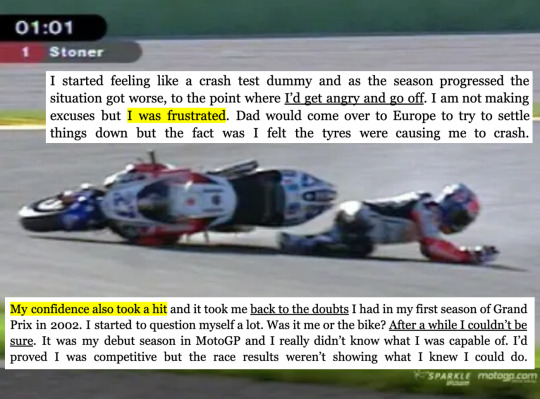



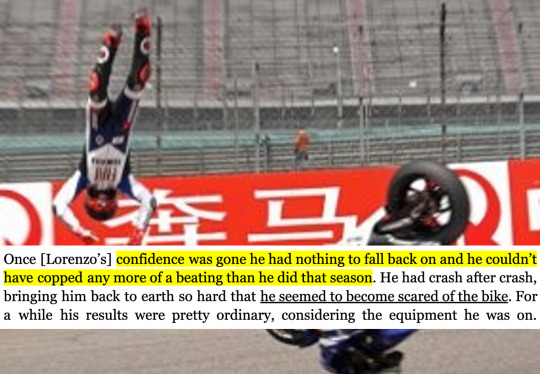




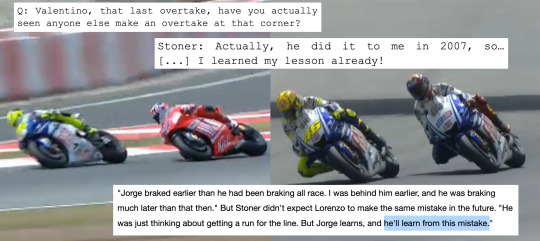
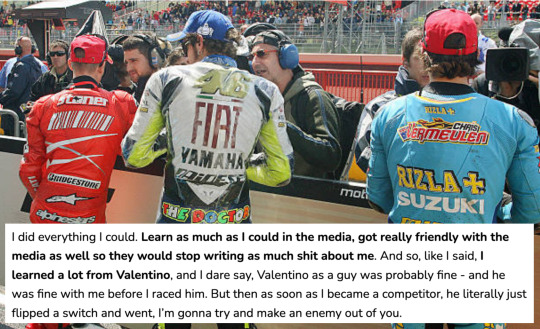

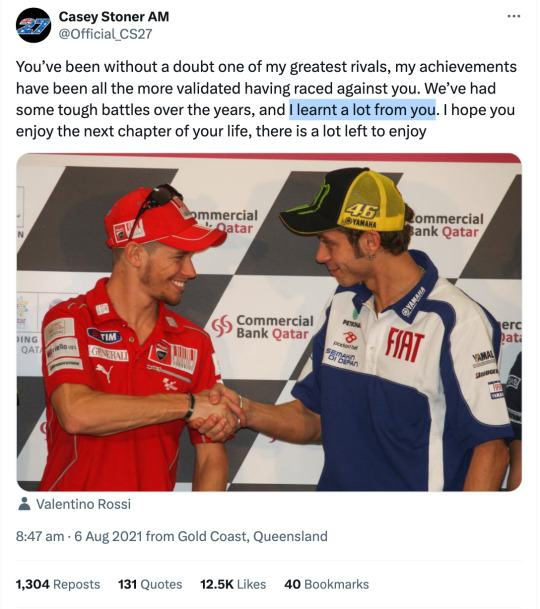

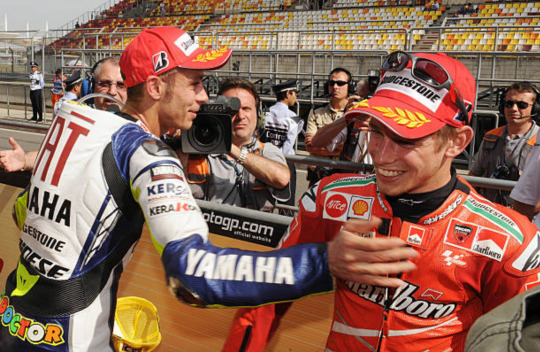

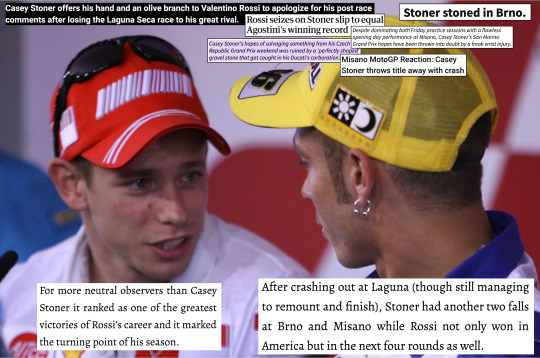


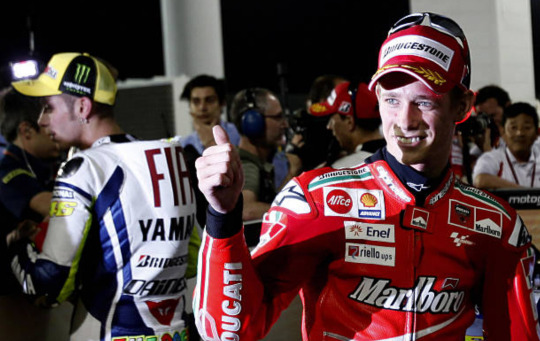

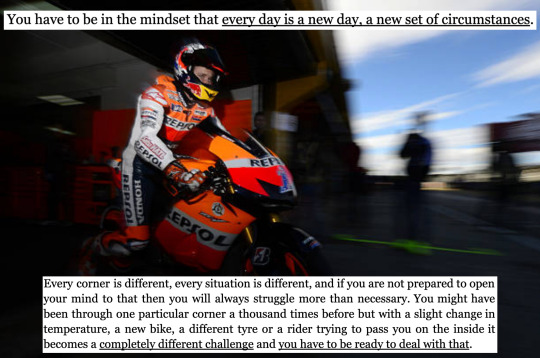







Casey Stoner - Confidence
Casey Stoner: Pushing the Limits (2013); Tales of Valentino (2021); MotoGP legend Casey Stoner talks early retirement, real feelings towards Valentino Rossi & Anxiety (2022); Rossi, Lorenzo and Stoner reflects on Catalunya thriller (2009); Casey Stoner: Last Lap Rossi Pass At Catalunya Was "Silly Mistake By Lorenzo" (2009); Casey Stoner Now Treasures His Bitter Tussles With 'Cunning' Valentino Rossi (2021); MotoGP, Casey Stoner vs mind games: "Why make enemies?" (2023); Casey Stoner tweet (2021); Valentino Rossi: The Definitive Biography (2020); 2008 MotoGP Brno (2008); Stoner stoned in Brno (2008); Stoner re-opens broken bone (2008); Misano MotoGP Reaction: Casey Stoner throws title away (2008); Livio Suppo: "Stoner would have suffered under Márquez" (2020); Casey Stoner Explains Why Qualifying Is Better Than Racing (2021); What's so special about Casey Stoner (2016)
#is this anything#casey stoner#valentino rossi#jorge lorenzo#marc marquez#//#cs27#mm93#jl99#vr46#this has been rotting in my drafts for literal months but I'm trying to answer casey asks and I kinda need some of this as background#sooooo much more material on this but well if tumblr thinks 30 images is enough it probably is
42 notes
·
View notes
Text


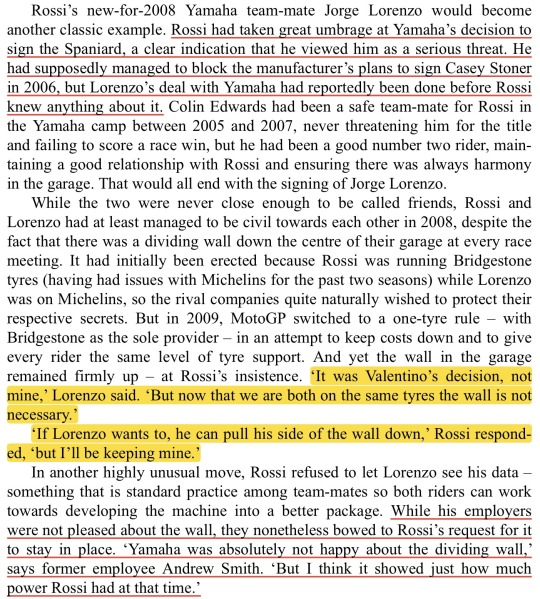
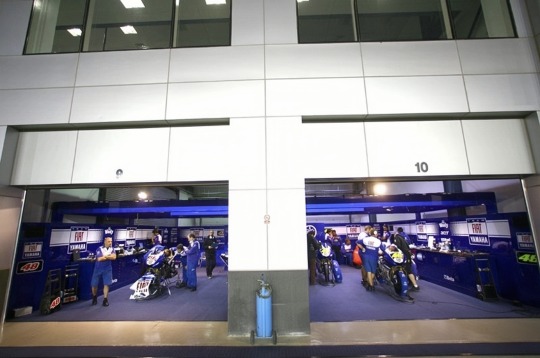


Casey Stoner: Pushing the Limits | Valentino Rossi: The Definitive Biography | Alex Marquez was blocked by Yamaha from joining SRT in MotoGP
86 notes
·
View notes
Text




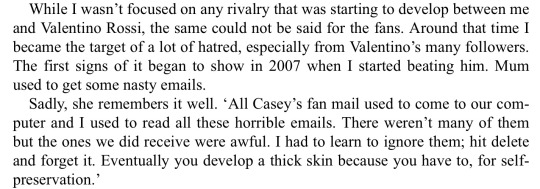
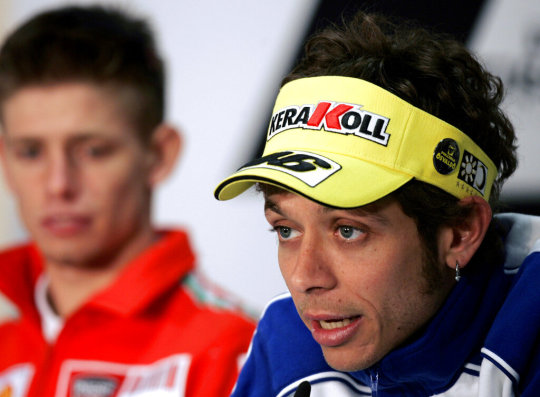
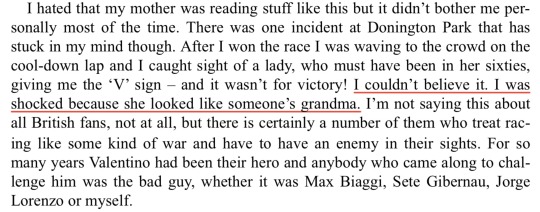


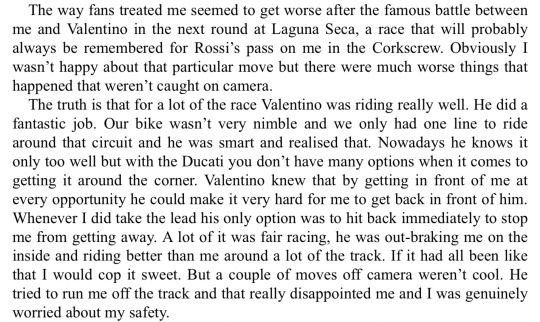
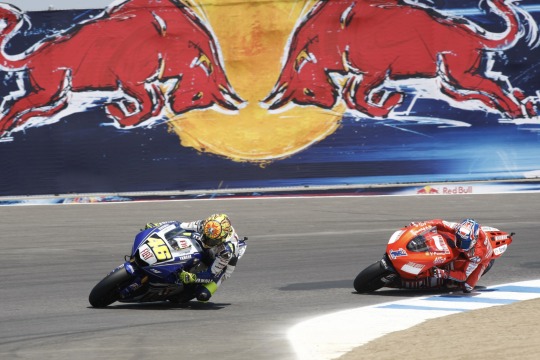
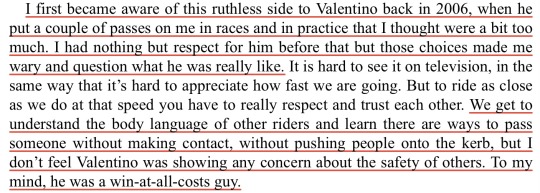

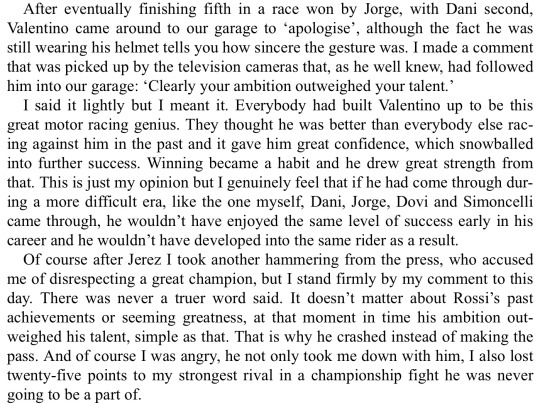
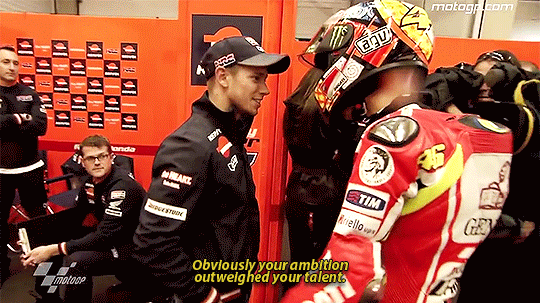



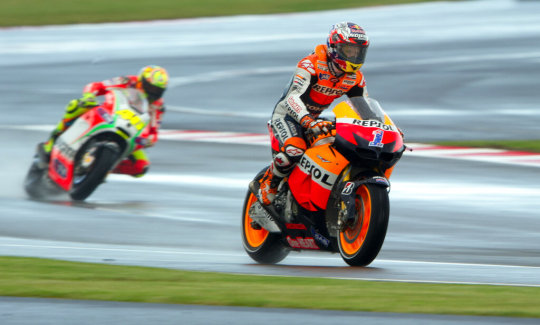
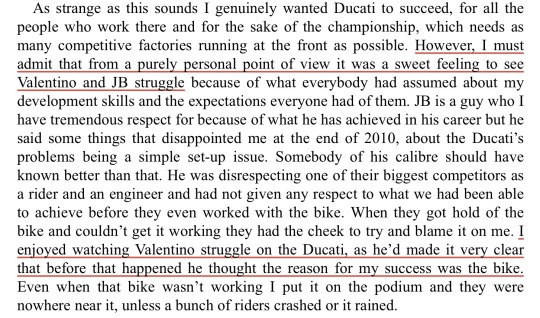
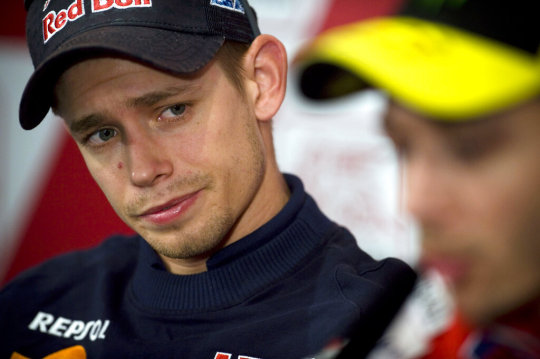
Casey Stoner: Pushing the Limits
77 notes
·
View notes
Text
New Post has been published on Superbike News
New Post has been published on http://superbike-news.co.uk/wordpress/ducati-world-premiere-2018-italian-symphony/
Ducati World Première 2018, “Italian Symphony"
(adsbygoogle = window.adsbygoogle || []).push();
Claudio Domenicali, CEO of Ducati, presents four new bikes and confirms the company’s constant growth.
The new Ducati bikes unveiled on the eve of EICMA 2017 in Milan are: Panigale V4, Ducati Scrambler 1100, Multistrada 1260 and 959 Panigale Corse
Streamed live worldwide: hundreds of thousands of people connected for the Ducati World Première 2018
Titled “Sinfonia Italiana” (“Italian Symphony”), the Ducati World Première 2018 gave the press and thousands of eager fans a preview of 4 new motorcycles that will be on show at EICMA 2017 from 9 to 12 November at the Milano-Rho trade fair centre.
This global event was held in the spectacular setting of the Linear Ciak theatre in Milan on the evening of Sunday 5th November. Streamed on the internet and broadcast in Italy live on SKY television, the Première saw Claudio Domenicali, CEO of Ducati Motor Holding, unveil the latest bikes, share the stage with international guests, celebrate a fantastic race season together with official Ducati Corse (MotoGP and WorldSBK) riders and illustrate the company’s recent achievements and future goals.
“Ducati is a global brand with a solid Italian core: sporting spirit, excellence in design, a love of beauty and a capacity to arouse great passion and build unique experiences”, stated Claudio Domenicali as he opened the Ducati World Premiere 2018. “We’re a 1,600-person orchestra. We’ve come a long way. Today, we conceive, design, and build inimitable motorcycles. Every day, together with our dealers, over 5,000 people all over the world are committed to providing motorcyclists from 93 countries with nothing less than perfection! Motorcyclists whose appreciation of our work and bikes is growing constantly. The year 2017 will, in fact, be the best in our history, the culmination of eight straight years of growth.
With these latest bikes in the 2018 range we aim to continue the “symphony” that stems from a team effort in which all members of the ‘orchestra’ interact in perfect harmony, each providing individual excellence to breathe life into our fantastic motorcycles.”
(adsbygoogle = window.adsbygoogle || []).push();
The first 2018 bike to be revealed was the Ducati Scrambler 1100, presented together with American model and influencer @Imogenocide, the star of the bike’s launch video (soundtracked by the Fun Lovin’ Criminals). The Scrambler 1100 also comes in a Special version, which draws its inspiration from the custom world, and a Sport version.
Also on stage was the Scrambler Mach2, the Desert Sled with a never-before-seen black livery and the new Street Classic.
The evening continued with the 959 Panigale Corse, which maintains the tradition of Ducati twin cylinder sport bikes. Characterised by new, exclusive components and an eye-catching livery, this bike was ridden onto the stage by SBK rider Chaz Davies, who arrived in Milan directly from Doha, in Qatar, where he had just completed the last round in the SBK world championship, finishing an impressive second in both the race and the championship.
Another new 2018 bike presented during the Ducati World Première was the Multistrada 1260. Mounting the new Ducati 1262 cm3 Testastretta DVT (Desmodromic Variable Timing) engine, it also features a new chassis set-up, more modern electronics and a re-style that includes side ‘wings’ and sportier-looking wheels. The Ducati “multibike” comes in several versions: the S version offers semi-active suspension and S D|Air – which maximises safety thanks to integration with an airbag-equipped jacket – while the Pikes Peak, the sportiest Multistrada version, features Öhlins mechanical suspension and forged aluminium wheels.
During the evening Claudio Domenicali also showcased the Multistrada 1200 Enduro Pro, set to play a pivotal role in DRE (Ducati Riding Experience) Enduro 2018 courses, the XDiavel, introduced by award-winning chef Massimo Bottura in a special video message, and the Monster 821, presented to the press last week.
The undisputed star of Ducati World Première 2018 was the S version of the new Panigale V4, the factory bike that comes closer to being a MotoGP prototype than anything ever seen. Ridden onto the stage by talented test rider Michele Pirro, this is the first mass-produced Ducati bike to mount a 4-cylinder engine derived directly from the Desmosedici GP.
The new Ducati supersport family is a concentrate of technology, style and performance. Constituting a new chapter in the company’s history, it also includes the exclusive, limited-edition, individually-numbered Panigale V4 Speciale.
The Panigale V4 Speciale – with dedicated livery, titanium exhaust and billet aluminium components – was ridden onto the stage by non other than top-class tester and Ducati ambassador Casey Stoner, the perfect grand finale to close out the event.
It is, then, a future-oriented, optimistic Ducati – and an array of dream bikes, accessories and apparel of outstanding style and originality – that awaits visitors (Hall 15, Stands N06 and N24) to the 75th edition of EICMA: clear confirmation, then, of the central role this iconic brand plays on the international motorcycling scene.
Ducati announces the dates of World Ducati Week 2018
(adsbygoogle = window.adsbygoogle || []).push();
0 notes